In Canada, during the arrival of warblers in spring and summer, it is common to spot yellow birds, but during the winter season, the American Goldfinch stands out as the most commonly seen yellow bird in the country.
To aid in the identification of yellow birds in Canada, this guide provides pictures, identification information, song recordings, and migration details.
The majority of yellow birds in Canada belong to the warbler, oriole, or tanager species, and sometimes female birds differ greatly in appearance from the males of their species.
With the comprehensive information provided in this guide, identifying yellow birds becomes much easier. The list of yellow birds is arranged in order of their frequency of sightings in Canada during spring and summer months, based on ebird checklists for May and June.
To discover the identity of the yellow birds you have spotted, continue reading.
20 Yellow Birds in Canada:
1. American Goldfinch
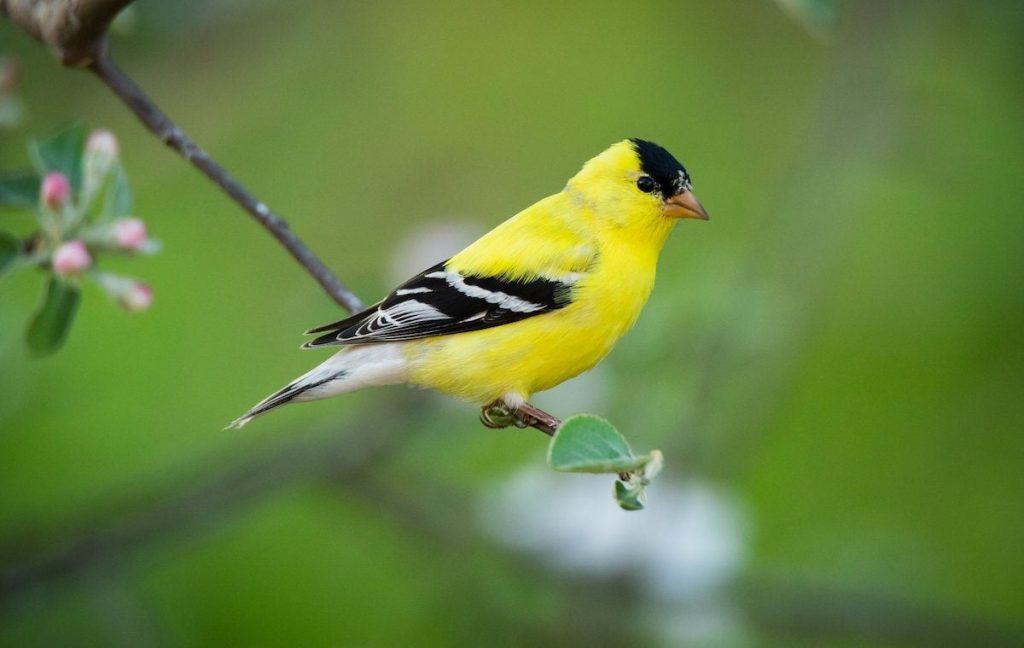
During the breeding season, American Goldfinches are the most frequently observed yellow birds in Canada. Some individuals remain in the southern regions throughout the year. They are present in 38% of summer checklists and 20% of winter checklists submitted by birdwatchers in the country.
American Goldfinches are popular among bird enthusiasts. The males display vibrant yellow and black plumage during spring, while the females have a more subdued brown coloration, similar to the appearance of males during winter.
Scientific name: Spinus tristis
Length: 4.3-5.1 inches (11-13 cm)
Weight: 0.4-0.7 ounces (11-20 g)
Wingspan: 7.5-8.7 inches (19-22 cm)
American Goldfinches can be found throughout most of North America and usually reside in their respective areas year-round. However, those that breed in Canada and the Midwest migrate to the southern regions of the United States during winter.
These birds can be spotted in weedy fields, overgrown areas, suburbs, parks, and even backyards. They forage on sunflower, thistle, and aster plants.
Listen to the song of the American Goldfinch.
The nests of American Goldfinches are typically built in saplings or shrubs. They consist of grass, bark strips, and feathers, and the female lays four to six eggs. The incubation period lasts ten to twelve days, during which the male provides food for the female.
To attract American Goldfinches to your backyard, consider planting thistles and milkweed. They are also frequent visitors to bird feeders, with a preference for sunflower and nyjer seeds.
Interesting fact: Brown-headed Cowbirds often lay their eggs in American Goldfinch nests. However, the seed-based diet provided by the goldfinch parents is unsuitable for the cowbird chicks, leading to their eventual demise.
2. Yellow-rumped Warbler
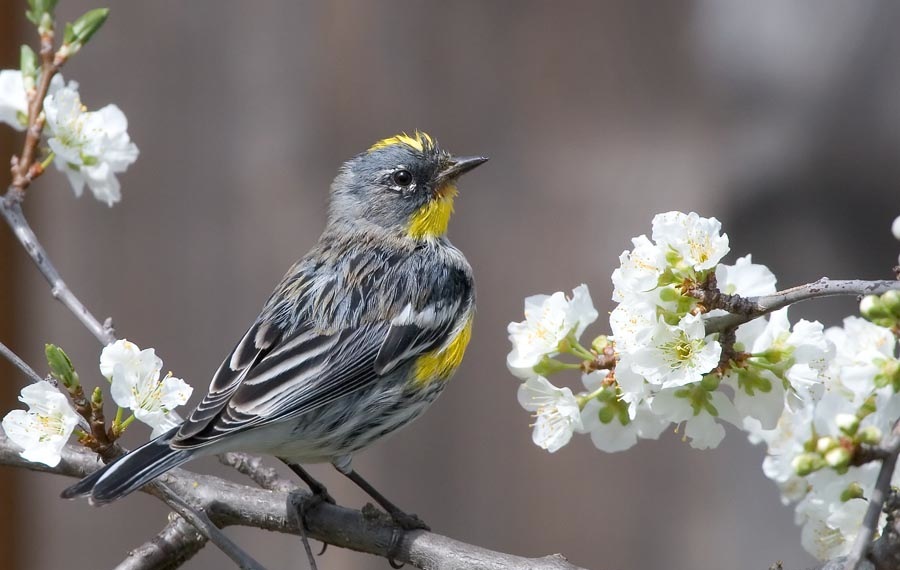
Yellow-rumped Warblers are more commonly observed in Canada during the summer, but their numbers increase during migration and they are also seen in southern regions. They appear in 20% of summer checklists and can be found on up to 34% of checklists during migration.
These warblers have gray plumage with flashes of yellow on their faces, sides, and rumps, along with white markings on their wings. Females may display a slight brown coloration, while winter birds exhibit paler brown feathers with bright yellow rumps and sides that transition back to yellow and gray in the spring.
Scientific name: Setophaga coronata
Length: 4.7-5.5 inches (12-14 cm)
Weight: 0.4-0.5 ounces (12-13 g)
Wingspan: 7.5-9.1 inches (19-23 cm)
Yellow-rumped Warblers primarily breed in Canada and parts of the Rockies and the Appalachian mountains. During migration, they can be observed in the Midwest before overwintering in southern and southwestern regions of the United States, as well as the Pacific Coast, Mexico, and Central America.
These warblers inhabit coniferous forests, especially during the breeding season. In winter, they can be found in open areas with fruiting shrubs. Their diet consists mainly of insects during summer and migration, while in winter, they primarily feed on fruit, including bayberry and wax myrtle.
Listen to the song of the Yellow-rumped Warbler.
Yellow-rumped Warblers build their nests in conifer trees using twigs, pine needles, and grass. The nests are lined with soft grass, moss, and hair. They lay up to six eggs, which hatch in approximately two weeks. The young birds leave the nest after an additional two weeks.
To attract Yellow-rumped Warblers to your backyard, provide sunflower seeds, suet, raisins, and peanut butter.
Interesting fact: During winter, Yellow-rumped Warblers form large flocks numbering in the thousands. They can exhibit aggression towards other bird species that come too close.
3. Cedar Waxwing

Cedar Waxwings spend their summers in Canada, primarily from June to September, although some individuals can be observed throughout the year. They are present in 18% of summer checklists and 1% of winter checklists in the country.
These elegant social birds have pale brown heads, chests, and crests that fade to gray on their backs and wings. Their bellies display a pale yellow color, and they have bright yellow tips on their tails. A narrow black mask covers their eyes, and their wingtips are adorned with bright red accents.
Scientific name: Bombycilla cedrorum
Length: 5.5-6.7 inches (14-17 cm)
Weight: 1.1 ounces (32 g)
Wingspan: 8.7-11.8 inches (22-30 cm)
Cedar Waxwings breed in Canada before migrating to the southern regions of the United States, Mexico, and Central America for winter. They can be found year-round in the northern states of the United States.
These birds can often be seen in berry bushes, woodlands, grasslands, towns, and along streams. While their diet primarily consists of fruit, they also consume insects during the summer.
Listen to the call of the Cedar Waxwing.
Cedar Waxwing nests are constructed in trees using twigs, grass, hair, and plant materials. The nests are lined with pine needles and soft grass. The female lays up to six eggs, which hatch in approximately twelve days. The young birds leave the nest after about sixteen days.
To attract Cedar Waxwings to your backyard, consider planting native trees and shrubs that bear small fruit, such as serviceberry, dogwood, juniper, winterberry, and hawthorn. You can also try placing fruit on platform feeders.
Interesting fact: Cedar Waxwings engage in a unique behavior of giving gifts to potential mates, passing objects between them as part of their courtship rituals.
4. Yellow Warbler
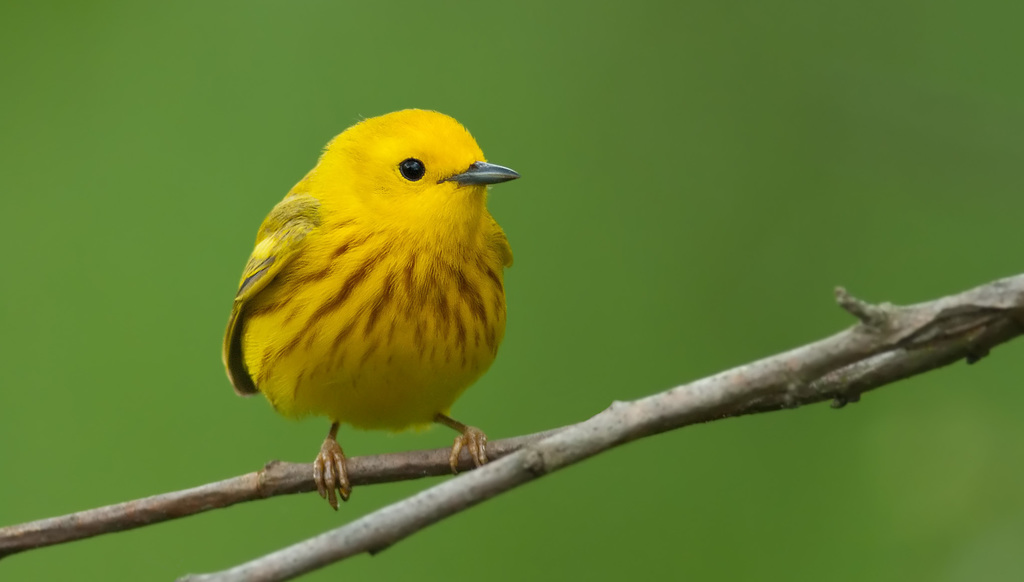
During summer, Yellow Warblers are the second most frequently spotted yellow birds in Canada, appearing in 26% of checklists during this season. They arrive in April and begin their migration in October.
Yellow Warblers are small, bright yellow birds with a yellow-green back. The males exhibit chestnut streaks on their breasts, while females and juveniles display less vibrancy compared to the males.
Scientific name: Setophaga petechia
Length: 4.7-5.1 inches (12-13 cm)
Weight: 0.3-0.4 ounces (9-11 g)
Wingspan: 6.3-7.9 inches (16-20 cm)
These warblers migrate long distances to breed in Canada and the United States (except southeastern states) before heading to Central and South America for winter. However, they can be spotted during migration in southeastern US states.
Yellow Warblers can often be found along streams, wetlands, thickets, and field edges, where they forage for insects such as caterpillars, midges, beetles, bugs, and wasps.
Listen to the song of the Yellow Warbler.
Their nests are built in small trees or shrubs using bark, grass, and plant materials intricately woven together and secured with spider webs to form a cup shape. The nests are then lined with softer materials such as hair, feathers, and plant down. Yellow Warblers lay up to seven eggs, which hatch in approximately twelve days, and the young birds leave the nest within ten days.
To attract Yellow Warblers to your backyard, provide suet, oranges, peanut butter, and plants with berries. Additionally, planting native plants that attract insects without the use of pesticides and maintaining a less tidy garden can be beneficial. Consider placing birdbaths with fountains near secluded planting areas to provide protection.
Interesting fact: When Cowbirds lay their eggs in Yellow Warbler nests, the warblers detect them and build a new nest on top of the old one, repeating this process up to six times.
5. Common Yellowthroat
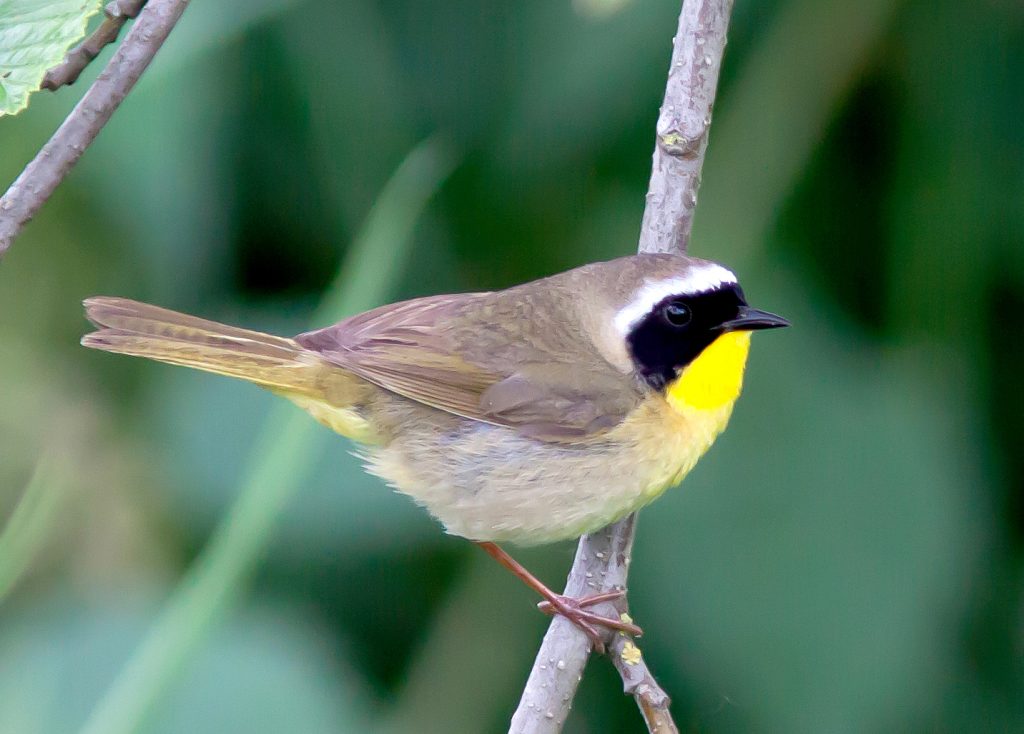
Common Yellowthroats spend the breeding season in Canada, primarily from April to October. They are observed in 21% of summer checklists.
These small songbirds have brownish backs and bright yellow undersides, with long tails. The males feature black masks across their faces. The intensity of their yellow coloration may vary geographically, and in some regions, they may appear more olive underneath.
Scientific name: Geothlypis trichas
Length: 4.3-5.1 inches (11-13 cm)
Weight: 0.3-0.3 ounces (9-10 g)
Wingspan: 5.9-7.5 inches (15-19 cm)
Common Yellowthroats spend the summer breeding across most of North America, excluding Alaska and northern Canada. Some individuals remain year-round along the Gulf Coast and Pacific Southwest. They migrate south for winter.
These birds are commonly found in marshy or wetland areas and brushy fields, inhabiting thick, tangled vegetation.
Listen to the song of the Common Yellowthroat.
Nests of Common Yellowthroats are built by females near the ground in marshy areas and are supported by reeds. The nests are made from grass and sedges woven into a platform of leaves and grass. Common Yellowthroats lay up to six eggs, which hatch in around twelve days, and the young birds leave the nest within a similar timeframe.
To attract Common Yellowthroats to larger backyards, provide dense vegetation and native plants to attract insects.
Interesting fact: The presence of a black mask on Common Yellowthroats serves as a visual signal to courting males, triggering aggressive behavior towards artificial birds with masks but not towards those without masks.
6. American Redstart Female

American Redstarts are commonly spotted in Canada from April to October, with a few individuals remaining until December. They appear in 14% of summer checklists.
Male American Redstarts sport mostly black plumage with bright orange patches and a white belly. Females, on the other hand, exhibit olive-gray coloring instead of black, along with multiple yellow patches.
Scientific name: Setophaga ruticilla
Length: 4.3-5.1 inches (11-13 cm)
Weight: 0.3-0.3 ounces (9-10 g)
Wingspan: 6.7-8.7 inches (17-22 cm)
These warblers breed in eastern North America, including Canada, and migrate to Central and South America for winter.
American Redstarts favor wooded habitats, including deciduous forests and forest edges, where they actively forage for insects by gleaning foliage and aerial hawking.
Listen to the song of the American Redstart.
American Redstarts construct cup-shaped nests in the lower branches of trees or shrubs, usually near water. The nests are made of grass, bark, and plant fibers, bound together with spider webs. The female lays three to five eggs, which hatch in approximately twelve days. The young birds leave the nest within ten days.
To attract American Redstarts to your backyard, provide a variety of native trees and shrubs for foraging and nesting opportunities. They may also be enticed by suet and mealworms during migration.
Interesting fact: American Redstarts are known for their flashy, acrobatic foraging behavior, rapidly fanning their tails and wings while gleaning insects from foliage.
7. Baltimore Oriole Female
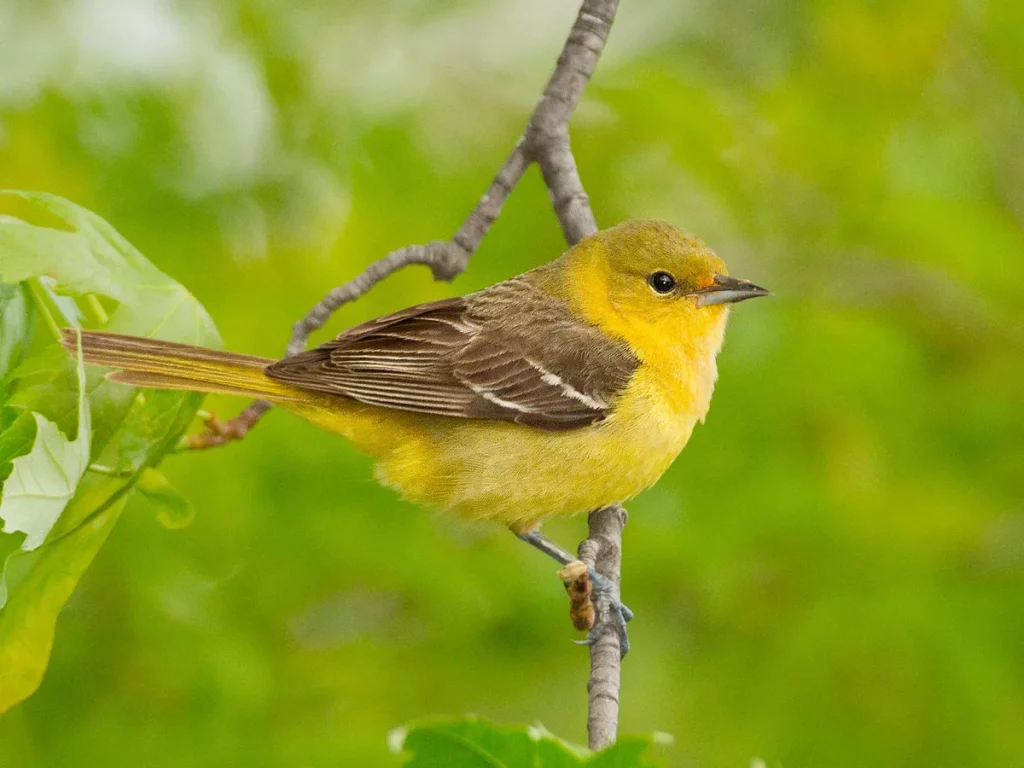
Baltimore Orioles are commonly observed in Canada from April to September, with a few individuals remaining until October. They appear in 15% of summer checklists.
Male Baltimore Orioles have vibrant orange plumage with black accents on their wings and head. Females, however, display more subdued colors, with yellow-orange undersides and grayish-brown upperparts.
Scientific name: Icterus galbula
Length: 6.7-7.9 inches (17-20 cm)
Weight: 1.1 ounces (31 g)
Wingspan: 9.8 inches (25 cm)
These orioles breed across eastern North America, including Canada, and migrate to Central and South America for winter.
Baltimore Orioles are commonly found in open woodlands, forest edges, and shade trees, where they forage for insects, spiders, fruit, and nectar.
Listen to the song of the Baltimore Oriole.
Their nests, hanging from the tips of branches, resemble pouches and are woven from plant fibers, grass, and strips of bark. Baltimore Orioles lay three to seven eggs, which hatch in approximately twelve days. The young birds leave the nest within two weeks.
To attract Baltimore Orioles to your backyard, provide nectar feeders with solutions containing one part sugar and four parts water. They are also attracted to orange halves and grape jelly. Planting native trees and shrubs that produce small fruits can also entice them.
Interesting fact: Baltimore Orioles are known for their intricate and beautiful nests, which are woven with such skill that they can retain water without leaking.
8. Pine Warbler
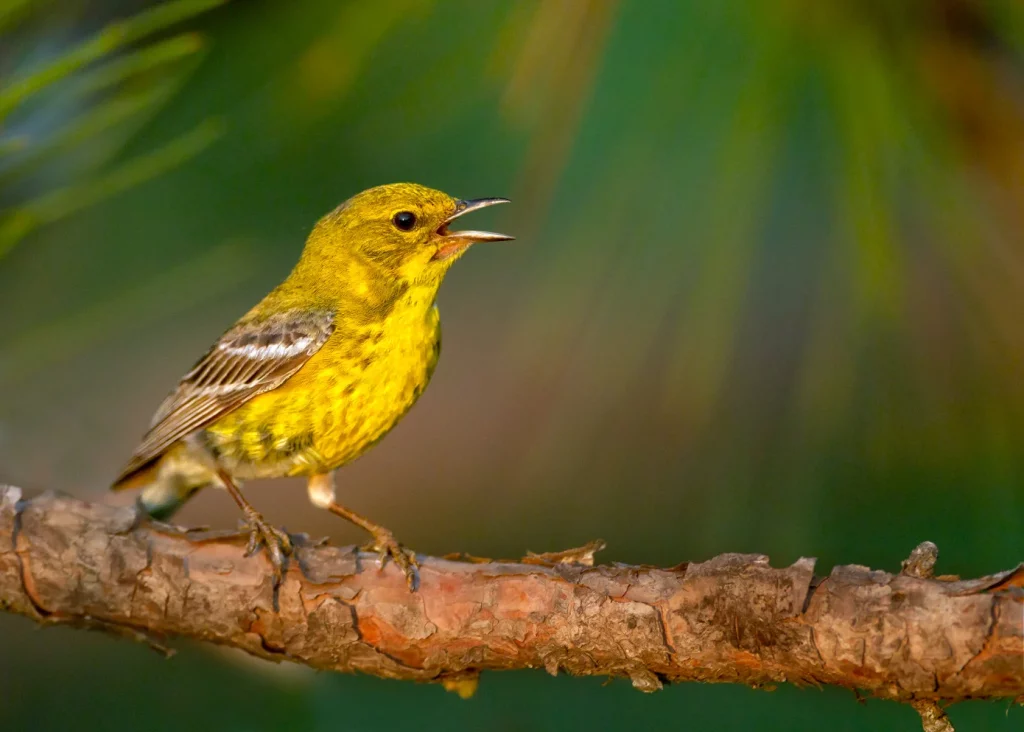
Pine Warblers are commonly spotted in Canada from April to October, although some individuals may remain until November. They appear in 10% of summer checklists.
These warblers have olive-gray upperparts with bright yellow undersides. They may exhibit faint brown streaks on their chests and have a narrow yellow eyering.
Scientific name: Setophaga pinus
Length: 4.7-5.5 inches (12-14 cm)
Weight: 0.3-0.3 ounces (9-10 g)
Wingspan: 7.5-8.3 inches (19-21 cm)
Pine Warblers breed in eastern North America, including Canada, and migrate to the southeastern United States for winter.
These birds favor pine forests and mixed woodlands, where they forage for insects, spiders, and seeds, primarily in conifers.
Listen to the song of the Pine Warbler.
Pine Warblers build cup-shaped nests on horizontal branches of trees, typically pine trees. The nests are made of bark strips, pine needles, and grass, and are lined with hair and feathers. The female lays three to five eggs, which hatch in around twelve days. The young birds leave the nest within ten days.
To attract Pine Warblers to your backyard, provide platform feeders with suet, sunflower seeds, and peanut butter. Planting coniferous trees, such as pines and spruces, can also create an inviting habitat.
Interesting fact: Pine Warblers are the only warbler species that regularly sings during winter, adding some melodic charm to the colder months.
9. Scarlet Tanager
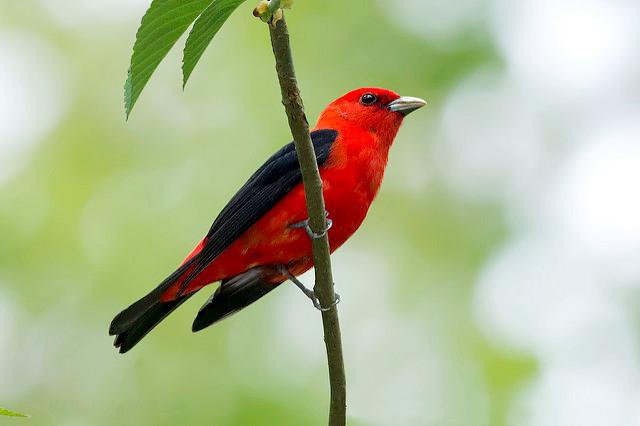
Scarlet Tanagers can be observed in Canada during the breeding season from May to August, with some individuals staying until September. They are present in approximately 7% of summer checklists.
These striking birds are known for their vibrant red plumage with contrasting black wings and tail. Adult females, however, have a more subdued olive-yellow coloration.
Scientific name: Piranga olivacea
Length: 6.3-7.5 inches (16-19 cm)
Weight: 0.8-1.1 ounces (23-31 g)
Wingspan: 10.2-11.4 inches (26-29 cm)
Scarlet Tanagers breed in deciduous forests across eastern North America, including Canada, and migrate to northern South America for winter.
They prefer the upper canopy of mature forests, where they feed on insects, spiders, and occasionally fruits and berries.
Listen to the song of the Scarlet Tanager.
Nests of Scarlet Tanagers are typically located in the horizontal forks of branches, high above the ground. The nests are constructed from twigs, leaves, and grass, and lined with finer materials such as rootlets and animal hair. The female lays three to four eggs, which hatch in approximately thirteen days. The young birds leave the nest within two weeks.
To attract Scarlet Tanagers to your backyard, provide a variety of mature trees and shrubs for nesting and foraging. They are particularly drawn to habitats with oak trees. Offering mealworms and suet can also be enticing.
Interesting fact: Male Scarlet Tanagers undergo a molt after the breeding season, transitioning from their vibrant red plumage to a more subdued yellow-green coloration similar to females and immatures.
10. Cape May Warbler

Cape May Warblers can be spotted in Canada during the breeding season from May to August, with some individuals staying until September. They appear in approximately 6% of summer checklists.
These warblers have a unique appearance with a yellowish-green overall coloration, streaked with black on their sides and back. They also feature a chestnut-colored cheek patch and a bold rusty crown.
Scientific name: Setophaga tigrina
Length: 4.3-5.1 inches (11-13 cm)
Weight: 0.3-0.4 ounces (9-11 g)
Wingspan: 7.5-8.7 inches (19-22 cm)
Cape May Warblers breed in the boreal forests of Canada and migrate to the Caribbean and northern South America for winter.
They inhabit a variety of forested habitats, including coniferous and deciduous forests, where they feed on insects, particularly those found in tree canopies.
Listen to the song of the Cape May Warbler.
Nests of Cape May Warblers are constructed in coniferous trees, typically near the end of a branch. The nests are made of twigs, grasses, and plant fibers, and lined with feathers and hair. The female lays three to five eggs, which hatch in approximately eleven days. The young birds leave the nest within ten days.
To attract Cape May Warblers to your backyard, provide feeders with sugar water or fruit jelly. Planting coniferous trees and shrubs, such as spruces and firs, can also create a suitable habitat.
Interesting fact: Despite its name, Cape May Warblers do not breed in Cape May, New Jersey. The name originated from an early specimen collected there in the 1800s.
11. Blackburnian Warbler
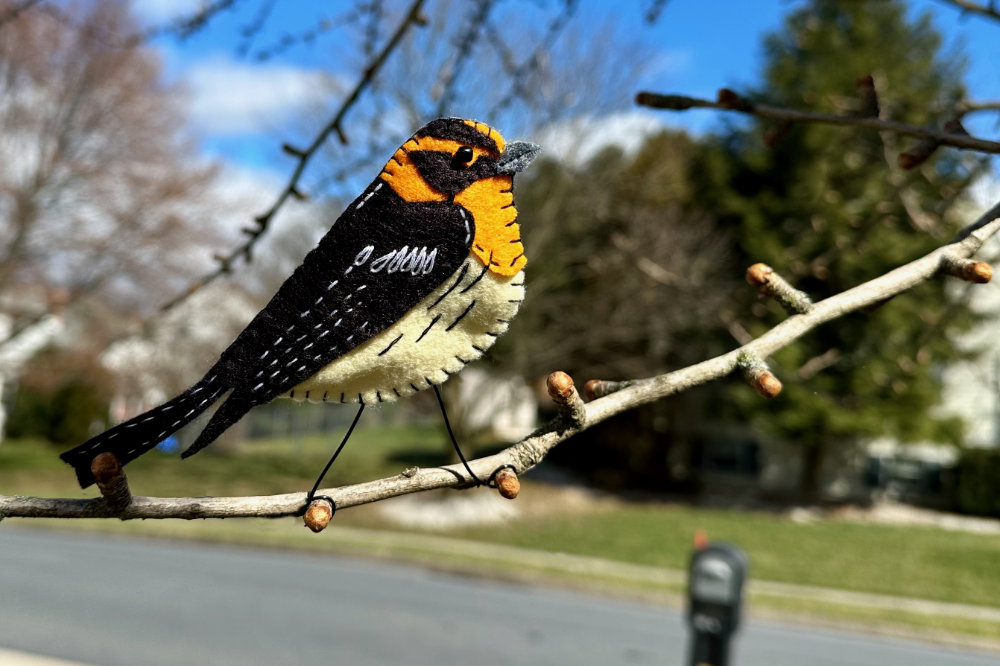
Blackburnian Warblers can be observed in Canada during the breeding season from May to August, with some individuals staying until September. They are present in approximately 5% of summer check
lists.
These eye-catching warblers are known for their fiery orange throat and breast, set against black and white plumage. The rest of their body is primarily black and white, with yellow patches on the wings.
Scientific name: Setophaga fusca
Length: 4.3-4.7 inches (11-12 cm)
Weight: 0.3-0.4 ounces (7-11 g)
Wingspan: 7.5-8.7 inches (19-22 cm)
Blackburnian Warblers breed in the boreal forests of Canada and migrate to northern South America for winter.
They prefer mature coniferous and mixed forests, where they forage for insects, especially those found on the outer branches of trees.
Listen to the song of the Blackburnian Warbler.
Nests of Blackburnian Warblers are usually located on horizontal branches of coniferous trees, often near the trunk. The nests are built using twigs, plant fibers, and moss, and lined with fine materials like rootlets and hair. The female lays three to four eggs, which hatch in approximately twelve days. The young birds leave the nest within ten days.
To attract Blackburnian Warblers to your backyard, provide a variety of coniferous trees and maintain a healthy insect population. Their presence can also be encouraged by offering suet and sugar water in feeders.
Interesting fact: Blackburnian Warblers have one of the highest breeding elevations of any warbler species, with some nests found as high as 5,000 feet (1,500 meters) above sea level.
12. American White Pelican

The American White Pelican is a large waterbird that can be seen in Canada during the breeding season from April to September. They are present in approximately 6% of summer checklists.
These pelicans have a distinctive appearance with their large white bodies, long wingspan, and a bright orange bill and pouch. During the breeding season, adults develop a prominent horn-like projection on their upper bill.
Scientific name: Pelecanus erythrorhynchos
Length: 50-70 inches (127-178 cm)
Weight: 9-30 pounds (4-14 kg)
Wingspan: 96-110 inches (244-279 cm)
American White Pelicans breed in freshwater wetlands and marshes across the northern United States and Canada. During the winter, they migrate to the southern United States and Mexico.
They are highly gregarious birds and often seen in large colonies, especially during the breeding season. They feed primarily on fish, using their large pouches to scoop up prey from the water.
Listen to the calls of the American White Pelican.
Nests of American White Pelicans are constructed on the ground, typically on islands or in isolated areas of wetlands. The nests are shallow depressions lined with vegetation. The female lays 2-3 eggs, which both parents take turns incubating for about a month. The young birds leave the nest at around 2-3 weeks old but continue to be cared for by their parents for several more weeks.
To attract American White Pelicans to your area, it’s essential to preserve and protect wetland habitats. They are highly dependent on healthy freshwater ecosystems for nesting and foraging.
Interesting fact: American White Pelicans engage in cooperative fishing, where they work together to corral and capture fish. They form a semicircular line and swim in unison to herd fish into shallow water, making it easier for them to catch their prey.
13. Ruffed Grouse

Ruffed Grouse, also known as partridge, can be found in Canada throughout the year. They are present in approximately 23% of winter checklists.
These medium-sized game birds have mottled brown plumage that provides excellent camouflage in their woodland habitats. They have a fan-shaped tail with a prominent dark band near the tip. Male grouse have a black throat patch, while females have a lighter brown throat.
Scientific name: Bonasa umbellus
Length: 16-19 inches (40-48 cm)
Weight: 17-25 ounces (480-700 g)
Wingspan: 20-25 inches (50-64 cm)
Ruffed Grouse are found in various forested habitats, including deciduous and mixed forests, where they feed on buds, twigs, leaves, and fruits, as well as insects during the summer.
Listen to the drumming sound of the Ruffed Grouse.
Nests of Ruffed Grouse are typically located on the ground, often at the base of a tree or under a fallen log. The nest is a shallow depression lined with leaves and other plant materials. The female lays 8-14 eggs, which she incubates for about three weeks. The young birds leave the nest shortly after hatching and are capable of independent foraging within a few days.
To attract Ruffed Grouse to your property, provide a mix of mature trees and shrubs, as well as areas of dense cover such as thickets and brush piles. Maintaining a diverse understory with plants that provide food and cover will help create an attractive habitat for grouse.
Interesting fact: Male Ruffed Grouse perform a unique courtship display called drumming. They create a low-frequency sound by rapidly
beating their wings against the air, which produces a drumming sound that can be heard up to a quarter-mile away. The drumming serves to attract females and establish territory boundaries.
14. Yellow-headed Blackbird
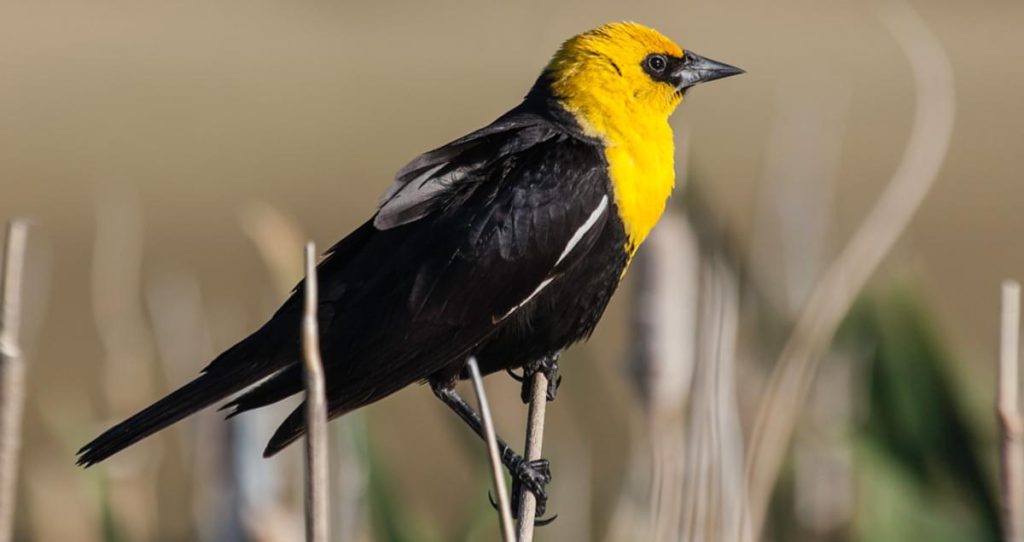
The Yellow-headed Blackbird is a striking bird species that can be spotted in Canada during the breeding season from May to August. They appear in approximately 5% of summer checklists.
These blackbirds have distinct yellow heads, black bodies, and white wing patches. Adult males have a bright yellow head and breast, while females and juveniles have a duller yellowish-brown head.
Scientific name: Xanthocephalus xanthocephalus
Length: 9-11 inches (23-28 cm)
Weight: 2-3.5 ounces (57-100 g)
Wingspan: 15-17 inches (38-43 cm)
Yellow-headed Blackbirds breed in marshes, wetlands, and tall grassy areas across western North America, including parts of Canada. During the winter, they migrate to southern parts of the United States and Mexico.
They are known for their distinctive, loud, and harsh calls that resemble rusty gate hinges or rusty farm machinery. Listen to the calls of the Yellow-headed Blackbird.
Nests of Yellow-headed Blackbirds are constructed in cattail marshes, bulrushes, or other emergent vegetation near water. The nests are suspended from vegetation above the water or attached to cattails. The female builds the nest using plant materials and weaves it into a sturdy cup shape. She lays 3-5 eggs, and both parents take turns incubating them for about two weeks. The young birds leave the nest within a week of hatching but continue to be fed by their parents for several more weeks.
To attract Yellow-headed Blackbirds to your area, create or preserve wetland habitats with dense vegetation. These birds rely on marshes and wetlands for breeding and nesting.
Interesting fact: Male Yellow-headed Blackbirds are polygynous, meaning they mate with multiple females. They defend territories within their breeding habitats and perform elaborate courtship displays to attract mates.
15. Canada Warbler
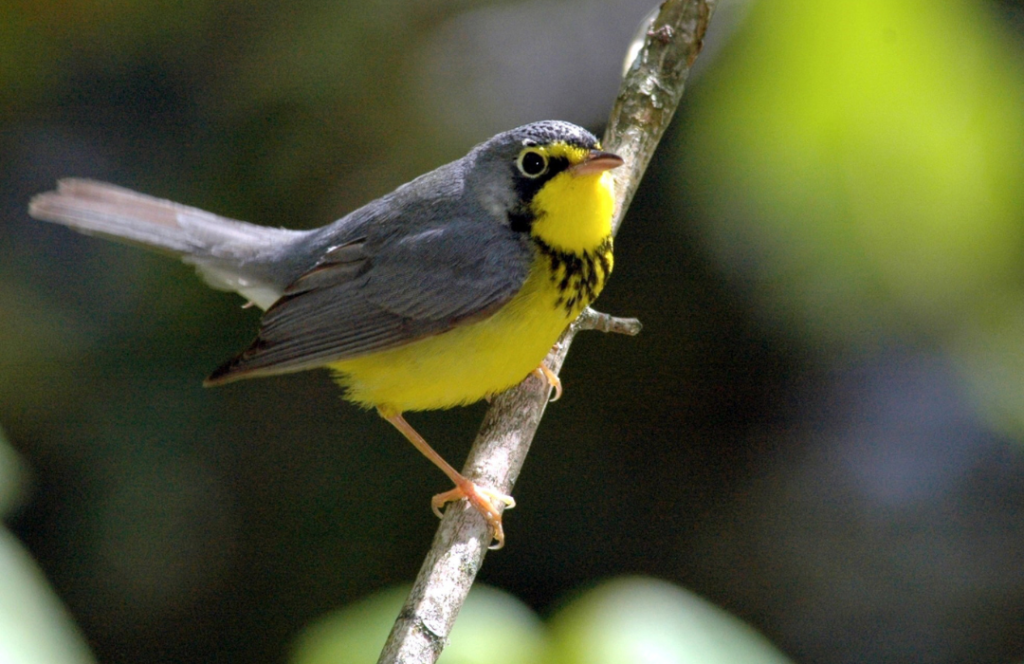
The Canada Warbler is a small migratory songbird that can be found in Canada during the breeding season from May to August. They appear in approximately 3% of summer checklists.
These warblers have a striking appearance with bluish-gray upperparts, yellow underparts, and a distinct necklace of black streaks across their breast. Males and females have similar plumage, although females may have slightly duller colors.
Scientific name: Cardellina canadensis
Length: 4.3-5.1 inches (11-13 cm)
Weight: 0.3-0.4 ounces (9-11 g)
Wingspan: 7.5-8.7 inches (19-22 cm)
Canada Warblers breed in dense, moist forests across Canada and parts of the northeastern United States. During the winter, they migrate to northern South America.
They are known for their sweet and melodic songs, which consist of rich whistles and trills. Listen to the song of the Canada Warbler.
Nests of Canada Warblers are typically located on or near the ground in dense shrubs or low vegetation. The nest is a cup-shaped structure made of grass, leaves, and moss, lined with finer plant materials. The female lays 4-5 eggs, which she incubates for about two weeks. Both parents feed the young birds until they fledge, which usually occurs within 10-12 days after hatching.
To attract Canada Warblers to your area, provide suitable habitat with dense understory vegetation and shrubs. Avoid excessive forest fragmentation and maintain a healthy, diverse forest ecosystem.
Interesting fact: Canada Warblers are insectivorous birds, feeding on a variety of insects and spiders. They often capture insects in mid-air during their agile flight.
That concludes the list of yellow birds commonly spotted in Canada. Whether you’re a birdwatching enthusiast or simply enjoy the beauty of nature, these vibrant and diverse bird species add a touch of color and charm to the Canadian landscape. Happy birdwatching!
16. Yellow-breasted Chat
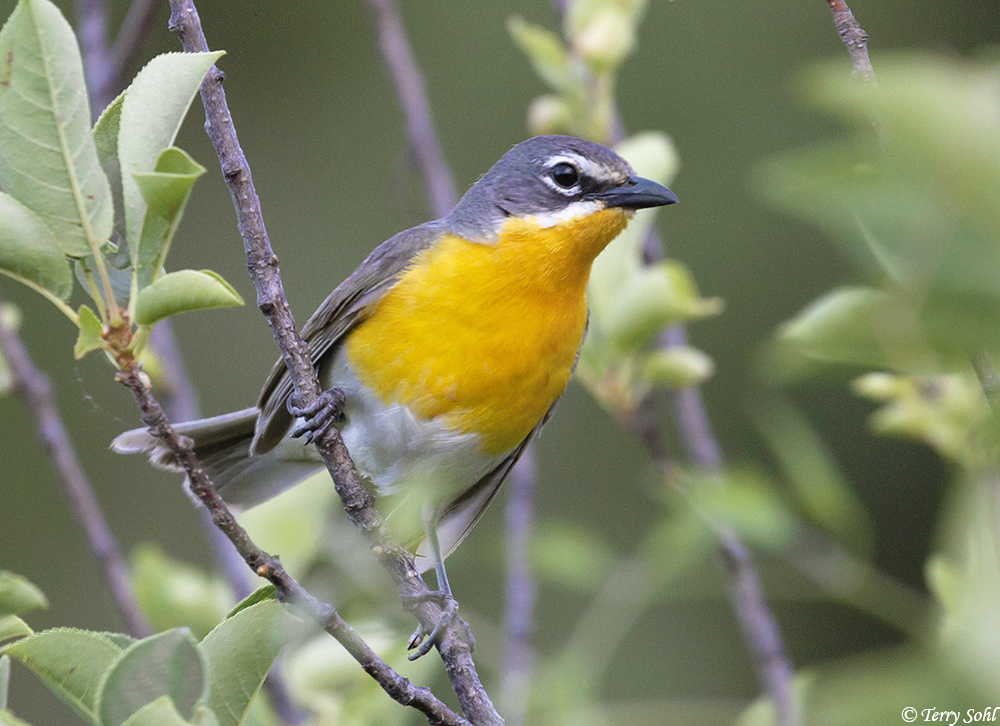
Yellow-breasted Chats can be seen in Canada during summer, mainly in the southeastern provinces, from May to August.
Yellow-breasted Chats are large songbirds with bright yellow breasts, olive-green backs, and white bellies. They have a distinctive, loud, and varied song.
Icteria virens
Length: 6.7-7.9 in (17-20 cm)
Weight: 1.1-1.6 oz (32-45 g)
Wingspan: 9.8-10.2 in (25-26 cm)
Yellow-breasted Chats breed in eastern and central North America and spend the winter in Mexico, Central America, and the Caribbean.
You can find Yellow-breasted Chats in dense thickets, shrubs, and tangled vegetation near wetlands and streams. They are often elusive and prefer to stay hidden within the vegetation.
Yellow-breasted Chat song:
Credit: David Vander Pluym, XC683767. Accessible at www.xeno-canto.org/683767.
Nests of Yellow-breasted Chats are usually built on or near the ground in dense shrubs or tangled vegetation. They are large, bulky structures made from twigs, leaves, and grass, lined with finer plant materials. The female lays 3-5 eggs, which she incubates for about two weeks. The young birds leave the nest within a week of hatching but continue to be fed by their parents for several more weeks.
Fun Fact: Yellow-breasted Chats have a unique vocal repertoire and can mimic the songs of other bird species, adding to their repertoire of sounds.
17. Yellow-throated Warbler

Yellow-throated Warblers spend the breeding season in Canada from May to August and occur in approximately 2% of summer checklists.
Yellow-throated Warblers are small songbirds with olive-green backs, yellow throats and chests, and white bellies. They have distinctive black masks and long, thin bills.
Setophaga dominica
Length: 4.7-5.9 in (12-15 cm)
Weight: 0.4-0.5 oz (11-14 g)
Wingspan: 7.5-8.3 in (19-21 cm)
Yellow-throated Warblers breed in southeastern US states and spend the winter in Mexico, Central America, and the Caribbean.
You can find Yellow-throated Warblers in mature deciduous forests, especially near water, where they forage for insects, spiders, and small fruits.
Yellow-throated Warbler song:
Credit: Michael McGuire, XC454241. Accessible at www.xeno-canto.org/454241.
Nests of Yellow-throated Warblers are built in the forks of tree branches, usually high above the ground. The nest is a cup-shaped structure made of bark strips, plant fibers, grass, and spider silk, lined with softer materials such as feathers and hair. The female lays 3-5 eggs, and both parents take turns incubating them for about two weeks. The young birds fledge within 10-12 days after hatching.
Fun Fact: Yellow-throated Warblers are excellent acrobats and can hang upside down to search for insects on the undersides of leaves.
18. Connecticut Warbler
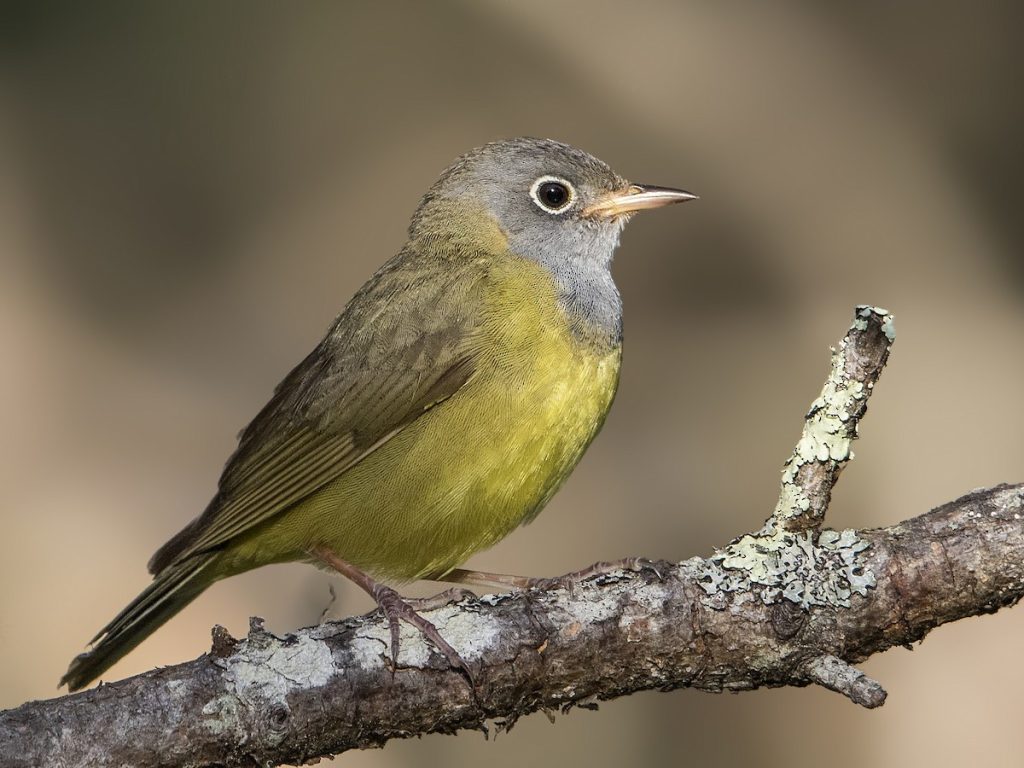
Connecticut Warblers can be observed in Canada during their breeding season, which typically spans from May to August. They are primarily seen in the southeastern provinces.
Connecticut Warblers are medium-sized songbirds with olive-green backs and pale yellow undersides. They have a distinctive gray hood and a bright white eye ring.
Oporornis agilis
Length: 5.5-6.3 in (14-16 cm)
Weight: 0.5-0.6 oz (14-17 g)
Wingspan: 7.9-9.4 in (20-24 cm)
Connecticut Warblers breed in the boreal forests of Canada and spend the winter in Central and South America.
You can find Connecticut Warblers skulking in dense understory vegetation, particularly near wet areas. They forage for insects and spiders by hopping along the ground and low vegetation.
Connecticut Warbler song:
Credit: Matt Wistrand, XC488082. Accessible at www.xeno-canto.org/488082.
Nests of Connecticut Warblers are constructed on or near the ground, usually hidden within dense vegetation. The nest is made from grass, leaves, and moss, lined with fine plant materials. The female lays a clutch of 4-6 eggs, which she incubates for approximately 12-13 days. The young birds leave the nest after about 10-12 days.
Fun Fact: The Connecticut Warbler is named after the state of Connecticut, where it was first discovered in the 19th century.
19. Palm Warbler
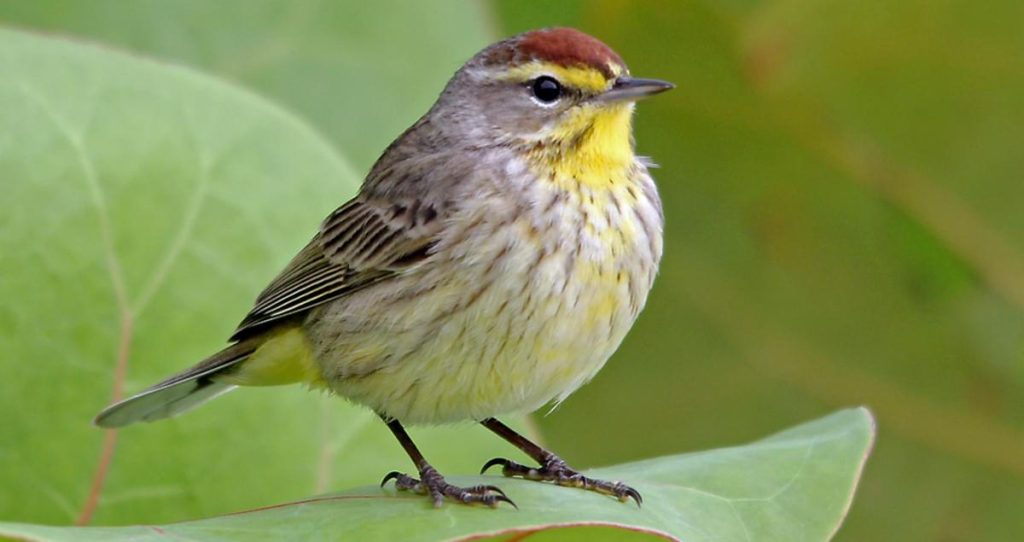
Palm Warblers spend their breeding season in Canada from late April to September and occur in approximately 2% of summer checklists. They are predominantly found in the southeastern provinces.
Palm Warblers are small songbirds with brownish-olive backs, pale yellow underparts, and distinctive rusty-brown caps. They have a habit of constantly wagging their tails.
Setophaga palmarum
Length: 4.7-5.5 in (12-14 cm)
Weight: 0.3-0.4 oz (8-11 g)
Wingspan: 7.5-8.3 in (19-21 cm)
Palm Warblers breed in boreal forests and wetlands across Canada and spend the winter in the southeastern United States, the Caribbean, and Central America.
You can find Palm Warblers on the ground, often near water, where they forage for insects, spiders, and small seeds. They are known for their tail-wagging behavior while feeding.
Palm Warbler song:
Credit: Andrew Spencer, XC396127. Accessible at www.xeno-canto.org/396127.
Nests of Palm Warblers are built on or near the ground, usually hidden in dense vegetation or moss. The nest is constructed from grass, twigs, and plant materials, lined with finer materials such as feathers and hair. The female lays a clutch of 4-5 eggs, which she incubates for about 12-13 days. The young birds leave the nest approximately 10-12 days after hatching.
Fun Fact: Palm Warblers have a distinct “chip” call that resembles the sound of two stones being tapped together.
20. Mourning Warbler

Mourning Warblers can be spotted in Canada during their breeding season from May to August. They are primarily found in the southeastern provinces.
Mourning Warblers are small songbirds with olive-green backs, yellow underparts, and a distinctive black mask across their face. They have a mournful, whistling song.
Geothlypis philadelphia
Length: 4.3-4.7 in (11-12 cm)
Weight: 0.3-0.4 oz (9-11 g)
Wingspan: 6.7-7.1 in (17-18 cm)
Mourning Warblers breed in dense shrubby areas and wetlands across Canada and the northeastern United States. They spend the winter in Central and South America.
You can find Mourning Warblers skulking in thick undergrowth and shrubby habitats, often near water. They forage for insects, spiders, and small fruits.
Mourning Warbler song:
Credit: Dan Lane, XC131342. Accessible at www.xeno-canto.org/131342.
Nests of Mourning Warblers are constructed on or near the ground, hidden among dense vegetation or moss. The nest is a cup-shaped structure made of grass, leaves, and moss, lined with fine plant materials. The female lays a clutch of 4-5 eggs, which she incubates for approximately 11-12 days. The young birds fledge within 9-11 days after hatching.
Fun Fact: Despite their somewhat mournful-sounding name, Mourning Warblers are delightful birds to observe during their breeding season, with their striking appearance and elusive behavior within the dense vegetation.
